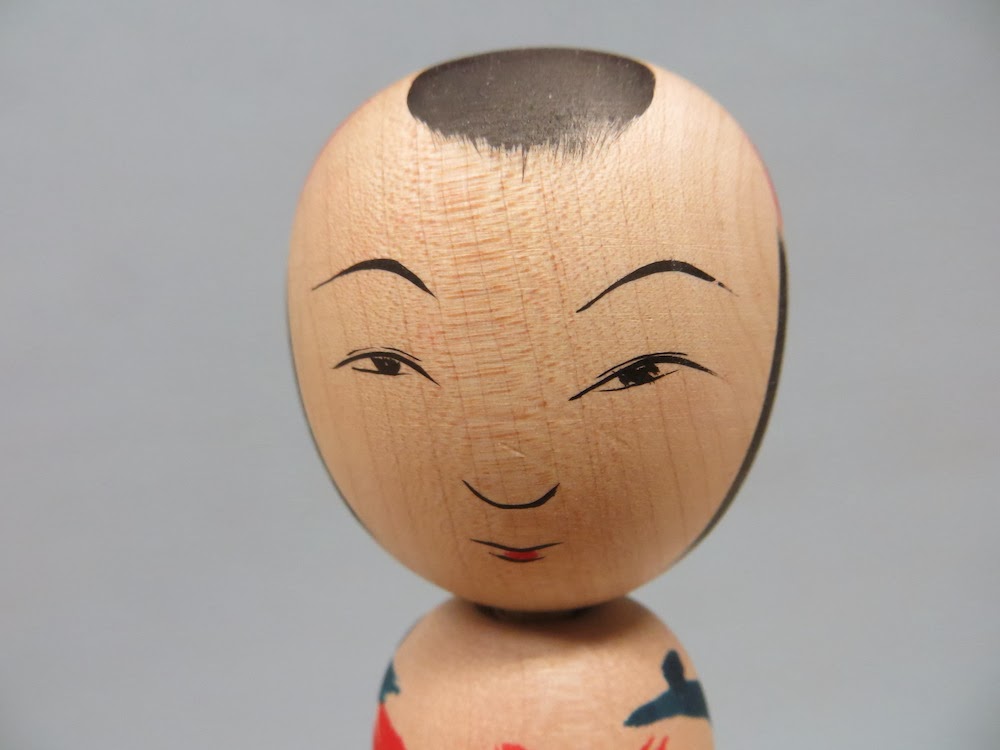The other day I walked into our local antique shop and noticed that there were a number of nice looking traditional kokeshis for sale, and for good prices too. I had been to the shop in the past and for the most part the kokeshis there were always old, faded, and not too interesting. However, this time I was in for a very pleasant surprise, and Naoko and I ended up purchasing five fine pieces. Before continuing I would like to say that I typically do not purchase antique kokeshis, mainly because I would prefer to get them new as this supports the craftsmen who have devoted their lives to the craft. Moreover, after a while our new kokeshis will get old and become antiques, so why bother buying used kokeshis? There are times, though, when purchasing an antique is the way to go. The obvious case is when a craftsman has passed away -- you either get his or her kokeshis used, or go without. The other instance when I might buy an antique kokeshi is in the case of hard-to-find kokeshis by actively working craftsmen. Some makers simply do not make that many kokeshis, and then supply and demand get out of balance. Having said the above, let me introduce two fantastic pieces that have entered our collection.
The first is a Tsugaru kokeshi 津軽系こけし of the Nuruyu Onsen branch by the late Mr. Sato Zenji 佐藤善二さん. Naoko did a little research and found out that Mr. Sato was not known for making Nuruyu kokeshis, so this piece is apparently unique in that regard. Meanwhile, I love the body shape, the simple lines, and of course the face with the whimsical expression.
The second kokeshi we discovered was a real find. It's another Tsugaru kokeshi, this time by still-active kokeshi master craftsman Mr. Kon Akira 今晃さん. Mr. Kon's kokeshis are extremely popular, but he doesn't make all that many. Moreover, he has been in poor health over the last couple of years which has limited his output even further. His style here appears simplistic, even primitive, but if you see his more refined pieces you know immediately that he is fully capable of creating perfect kokeshis. Rather, he chooses to make them look unrefined. Naoko and I are both big fans of Mr. Kon's work, but it's truly difficult to get a hold of his kokeshis.
Overall, this was a small but nice kokeshi adventure. I'll show the others that we found at the antique shop in the next blog entry.
The first is a Tsugaru kokeshi 津軽系こけし of the Nuruyu Onsen branch by the late Mr. Sato Zenji 佐藤善二さん. Naoko did a little research and found out that Mr. Sato was not known for making Nuruyu kokeshis, so this piece is apparently unique in that regard. Meanwhile, I love the body shape, the simple lines, and of course the face with the whimsical expression.
Here's the bottom which contains some good information. It's hard to see, but the writing in pencil is a date -- October 9th, 1984 -- and the kokeshi's size -- 8 inches (8寸). What does that date signify I wonder? When it was made, or when it was purchased? Mr. Sato retired in 1985, and died in 1986, so this is most likely a kokeshi made at the end of his career. The writing in ink, from right to left, says "Nuruyu" (the name of kokeshi's the sub-branch), then "Itaro-gata" 伊太郎型, which Naoko believes is this simple kokeshi style, and then Mr. Sato's first name Zenji. This kokeshi has required a bit of detective work which has been fun, and I'm sure we'll learn more about it in the future.
The second kokeshi we discovered was a real find. It's another Tsugaru kokeshi, this time by still-active kokeshi master craftsman Mr. Kon Akira 今晃さん. Mr. Kon's kokeshis are extremely popular, but he doesn't make all that many. Moreover, he has been in poor health over the last couple of years which has limited his output even further. His style here appears simplistic, even primitive, but if you see his more refined pieces you know immediately that he is fully capable of creating perfect kokeshis. Rather, he chooses to make them look unrefined. Naoko and I are both big fans of Mr. Kon's work, but it's truly difficult to get a hold of his kokeshis.
 |
| Mr. Kon's signature. The date written in pencil says October 25th, 1986, so it's nearly 30 years old. |
 |
| Here are our two new Tsugarus together for a size comparison. |

















































